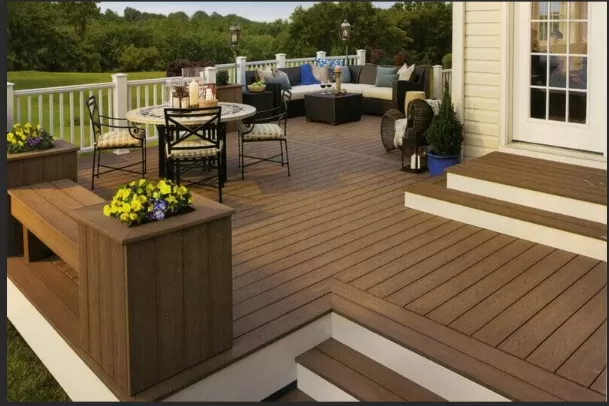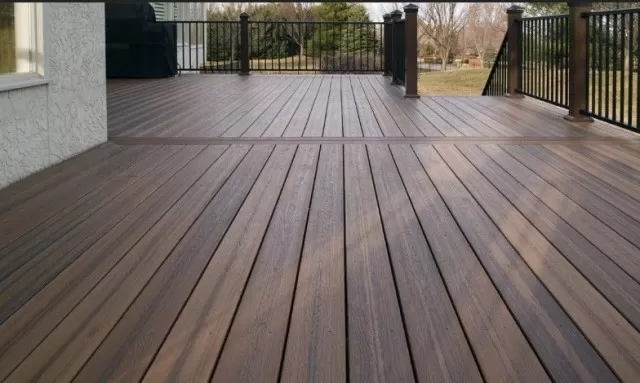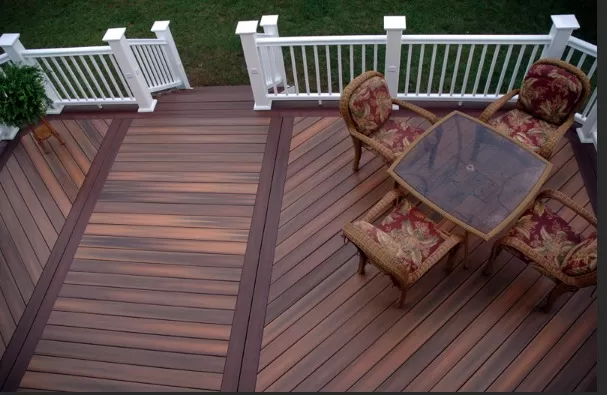The Best Decking Material Unveiled. When it comes to choosing the right type of tile for your project, porcelain and ceramic are two popular options. While they may look similar, there are important distinctions between the two.
Understanding their similarities and key differences can help you make an informed decision.When selecting a decking material, consider your desired aesthetics, long-term durability, maintenance requirements, and budget constraints. It’s also beneficial to consult with a decking professional who can provide guidance tailored to your specific needs and preferences. By carefully evaluating these factors, you can find the perfect decking material to bring your dream deck to life.
Cost Considerations and Maintenance for Natural Wood Decking

Exploring the Durability and Beauty of Natural Wood Decking, Despite the High Costs Involved.
Natural wood decking, renowned for its durability and aesthetic appeal, remains a popular choice among homeowners.
Whether you prefer the timeless elegance of cedar, the rustic charm of redwood, or the exotic allure of tropical hardwoods, these materials offer a range of options to suit various tastes. With their ability to resist rot and repel insects, they provide a reliable outdoor surface.
However, it’s important to note that the benefits of natural wood decking come at a price, both in terms of finances and maintenance.
When it comes to the cost of natural wood decking, the price varies depending on the type of wood you choose.
Cedar, a popular choice known for its affordability and quality, typically costs around $3. 75 per square foot.
On the other hand, redwood, which boasts exceptional durability and is more readily available on the west coast, tends to be priced at approximately $8 per square foot. However, if you have your heart set on exotic hardwoods, such as teak or ipe, be prepared to invest significantly more, as prices can exceed $20 per square foot.
While the initial expense may seem steep, it’s crucial to consider the long-term value and beauty that natural wood decking can bring to your outdoor space.
However, to preserve your investment and maintain its appearance, proper maintenance is essential. Without regular care, natural wood decking is susceptible to fading and cracking over time.
To prevent this, it’s advisable to employ maintenance practices such as pressure washing and re-sealing every couple of years. By taking these precautions, you can ensure that your natural wood deck remains in tip-top shape, allowing you to enjoy its durability and allure for years to come.
In summary, natural wood decking offers a durable and visually appealing option for homeowners.
While the costs may be high, the variety of wood choices allows for customization to fit individual preferences. It’s important to factor in the expenses associated with different wood types, ranging from the affordable cedar to the pricier exotic hardwoods.
Moreover, regular maintenance, including pressure washing and re-sealing, is crucial to preserve the deck’s beauty and prevent deterioration. By making informed decisions and investing in proper care, homeowners can enjoy the timeless charm of natural wood decking while maximizing its longevity.
Affordable and Durable: Exploring Pressure-Treated Lumber as a Cost-Effective Wood Decking Option
For homeowners seeking a budget-friendly alternative to natural wood decking, pressure-treated lumber emerges as a popular and accessible choice.
Crafted from southern pine infused with a protective chemical, this decking material offers resistance against rot, moisture, and insects. Notably, pressure-treated wood is the most economical option available, making it widely favored among homeowners. Its affordability, durability, and resemblance to natural wood contribute to its popularity. Additionally, its ease of use and versatility make it an excellent option for DIY enthusiasts, as it can be easily cut and secured with nails or screws.
When considering pressure-treated wood for your deck installation, it is advisable to avoid the cheapest budget varieties.
Although they may initially seem appealing due to their lower price, these options are more prone to developing cracks, warps, and splits over time. Opting for higher quality pressure-treated lumber can help you avoid future repair costs and ensure the longevity of your deck.
It is important to note that pressure-treated wood has one significant drawback: the chemicals infused in the lumber can release toxic gases if burned.
To minimize any potential exposure to these chemicals, it is crucial to regularly apply a reliable sealer when staining the deck every few years. This precautionary measure will help maintain a safe and healthy environment when utilizing the deck.
Additionally, homeowners should plan to pressure wash the deck annually to keep it clean and free from debris.
In summary, pressure-treated lumber offers an affordable and durable option for homeowners seeking a wood decking solution.
Its availability and cost-effectiveness make it a popular choice among individuals on a budget. With its resemblance to natural wood and ease of installation, it satisfies both aesthetic and practical considerations.
However, it is essential to select higher quality pressure-treated wood to avoid potential issues in the long run. By following proper maintenance practices, such as applying a sealer and annual pressure washing, homeowners can enjoy their pressure-treated wood deck while ensuring the safety and longevity of their investment.
Low-Maintenance and Stylish: Exploring the Benefits and Considerations of Composite Decking

For homeowners seeking a durable and visually appealing decking option with minimal maintenance requirements, composite decking emerges as a popular choice.
Manufactured by reputable brands such as Trex and TimberTech, composite decking is crafted from a combination of recycled plastics (polyethylene, polypropylene, or PVC) and wood fibers (such as wood chips or sawdust). This unique composition results in a resilient synthetic material that resists warping, rot, and insect infestations.
.
One of the significant advantages of composite decking is its wide range of colors and styles.
Whether you desire the look of natural wood or prefer a more contemporary aesthetic, there are numerous options available to suit your preferences. Unlike natural wood decking, composite boards do not require sealing, sanding, or staining unless you wish to change the color later on, making them incredibly low-maintenance.
However, it is important to consider a few drawbacks associated with composite decking.
Dark-colored composite boards can become excessively hot when exposed to direct sunlight, which may affect the comfort of walking on the deck with bare feet. Additionally, in areas that are shady, cool, or damp, mold and mildew can develop on the surface, requiring periodic cleaning and maintenance.
Another consideration is that the surface of composite decking can be slippery when wet, so it is advisable to allow adequate time for the deck to air-dry after cleaning before inviting guests to prevent accidents.
In summary, composite decking offers an attractive and low-maintenance solution for homeowners.
With its blend of recycled plastics and wood fibers, it provides durability and resistance against common issues faced by natural wood, such as warping, rot, and insects. The wide array of colors and styles allows for customization, while the elimination of sealing, sanding, and staining simplifies upkeep.
However, it is important to be aware of potential heat retention, mold growth in shaded areas, and slipperiness when wet. By considering these factors and implementing proper maintenance practices, homeowners can enjoy the long-lasting beauty and convenience of composite decking.
Durable and Low-Maintenance: Exploring the Pros and Cons of Plastic Decking
Plastic decking, with a price range of $7 to $10 per square foot, offers long-lasting performance, although its synthetic appearance may not match the natural look of other materials.
The most common plastic decking material is polyvinyl chloride (PVC), although there are also options available made from polyethylene. Similar to composite decking, plastic decking boasts durability and easy maintenance, typically requiring only regular cleaning with a garden hose or basic mopping.
One of the notable advantages of plastic decking is its exceptional durability.
It resists warping, cracking, and splitting over time, and it is impervious to moisture, rot, decay, and insect infestations. Furthermore, the surface of plastic decking does not need to be sanded, stained, or sealed, making it a low-maintenance option.
However, plastic decking does come with a few drawbacks.
Firstly, the surface of plastic decking can become extremely hot when exposed to direct sunlight, which can make it uncomfortable to walk on with bare feet. Additionally, shaded areas can be susceptible to Mold and Mildew growth, necessitating periodic cleaning.
While plastic decking is available in a variety of colors and styles, it’s important to note that darker colors may fade over time, and lighter colors may develop a chalky coating.
In summary, plastic decking offers a durable and easy-to-maintain option for homeowners.
With its resistance to warping, cracking, and insects, it provides long-lasting performance. Regular cleaning is typically the only maintenance required, and the absence of sanding, staining, or sealing simplifies upkeep.
However, the surface can become hot in direct sunlight, and mold and mildew may develop in shaded areas. Additionally, color retention may vary, with darker colors prone to fading and lighter colors potentially developing a chalky appearance.
By considering these factors and undertaking proper care, homeowners can enjoy the durability and convenience of plastic decking for their Outdoor Spaces.
Industrial Durability: Exploring the Advantages and Considerations of Aluminum Decking

For homeowners seeking an exceptionally durable and low-maintenance decking option, aluminum decking presents numerous advantages, albeit with an industrial appearance.
Priced between $7 to $10+ per square foot, aluminum decking is commonly used near swimming pools and lakes due to its longevity and resistance to harsh weather conditions. Most aluminum decking options feature a baked-on, powder-coated, or anodized finish, ensuring its ability to withstand the elements.
One of the significant benefits of aluminum decking is its outstanding resistance to mold, mildew, and staining.
Unlike other materials, aluminum will not rust, rot, crack, or peel over time, ensuring its long-lasting performance. Additionally, many aluminum decking products come with a non-skid textured surface, reducing the risk of slips and falls.
Surprisingly, aluminum decking manages to remain cool even on the hottest days, providing a comfortable surface for bare feet.
However, it is important to consider the drawbacks of aluminum decking.
Its combination of benefits makes it one of the most expensive options on the market, second only to certain varieties of natural wood. The price, along with its distinct industrial appearance, may not be suitable for every homeowner.
It is crucial to assess whether the aesthetic fits the desired style of the outdoor space.
In summary, aluminum decking offers exceptional durability and low maintenance for homeowners.
Its resistance to mold, mildew, staining, and corrosion, paired with its non-skid surface and ability to stay cool, make it a desirable choice. However, the higher price point and industrial appearance should be taken into consideration before making a decision.
By weighing these factors and aligning them with personal preferences, homeowners can determine if aluminum decking is the right fit for their outdoor area.
*The information is for reference only.